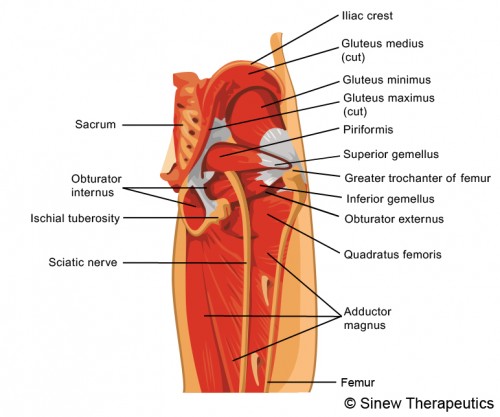Sciatica, or sciatic neuritis, is a medical term used to describe a type of pain that radiates down the sciatic nerve and sciatic nerve branches. It’s important to distinguish that sciatica is not a disease or comprehensive diagnosis, it’s merely a specific set of descriptive symptoms. This is important to remember since the underlying causes are vast and often require very different approaches to initiate improvement.


Anatomy As It Relates To Sciatica
The sciatic nerve is comprised of five sets of paired nerve roots and is the longest nerve in the human body. These nerve roots are located at the L5 and L4 vertebrae. The sciatic nerve runs from the lumbar spine, through the pelvic area (sacrum), and then down each leg. Smaller nerves branch out from the sciatic nerve as it reaches the knee. These branches then travel further down toward the feet.
The sciatic nerve is the nerve responsible for sensation to many areas of the lower leg, the foot sole, and the back of the thigh. Muscles in the back of the knee and lower leg are also controlled by the sciatic nerve.
What Is Sciatica?
Pain that radiates the same path of the sciatic nerve and related branches. As mentioned above, this pain is a signal of another disease process, condition, or injury that is placing pressure or has caused damage to part of the sciatic nerve. In most cases, sciatica is the result of compression to the L4 or L5 lumbar nerves or the S3, S2, or S1 sacral nerves. There are an array of conditions, injuries, and diseases that can cause these compressions to occur.
Common Causes Of Sciatic Pain
Any process or action that compresses or damages the sciatic nerve can cause sciatica. Examples of such include the following:
* herniated disk - when the liquid center of a disc bulges outward from a tear and compresses the nerve root against vertebra
* spinal tumors
* car accidents, falls, hits, and other traumas to the spine
* lumbar spinal stenosis - a narrowing in certain areas of the spine.
* spondylolisthesis - a vertebra slipping slightly forward over a neighboring vertebra.
* piriformis syndrome - tightening or spasms of the pirformis muscle
* prolonged sitting
* pelvic fracture or pelvic injury
* pregnancy
Symptoms Of Sciatica
The pain experienced from sciatica varies greatly from a mild tingling, dull ache, burning sensation, or intense pain. The degree of pain and specific location all depends on the cause of nerve compression. The pain typically only affects one side of the body. Symptoms may include the following:
* Pain in the buttocks area or leg
* Pain that is worse when sitting; during the night; after sneezing, laughing, or coughing; and with walking distances more than a few yards
* Burning or tingling sensations down the leg and possibly into the sole of the foot
* Difficulty moving or weakness moving the foot or leg
* When trying to stand, a shooting pain may cause difficulty rising.
Strengthening Exercises
These Sciatica Exercises are ideal to build strength and flexibility.
Massage Treatment
These Sciatica Massage Techniques are of great value in pain relief; circulation stimulation; dispersing blood and fluid accumulations; swelling reduction; and relaxing muscle spasms, especially when used alongside the Sinew Therapeutics liniments, soaks and massage oil.
ACUTE STAGE SYMPTOMS AND TREATMENT
This stage is characterized by swelling, redness, pain, and possibly a local sensation of heat, indicating inflammation. If coolness makes your pain feel better, then the Acute Stage Treatment is recommended.
ACUTE STAGE SYMPTOMS:
The acute stage starts the moment an injury occurs and lasts until the swelling and inflammation are gone. The swelling is the result of the blockage of blood, tissue fluids and circulation in the buttock because their normal movement has been disrupted by the force of the injury. Just like cars buttock up behind a traffic jam, causing congestion, exhaust and overheating; blood and fluids buttock up behind the injured buttock, causing pain, inflammation, lumps and swelling.
The sensation of heat is due to the warming action of the blood and fluids overheating in the injured buttock as they buttock up and accumulate. Stiffness and decreased mobility are due to spasms in tendons and ligaments that have contracted reflexively beyond their normal range from the impact of the injury.
As ligaments and tendons stretch and tear, blood from ruptured blood vessels becomes trapped in the local tissues. As the trapped blood clots up, it sticks the tissues together creating adhesions. Adhesions cause pain, inflammation and restricted movement because the layers of tissue that used to slide smoothly across one another now adhere and snap which interferes with normal functioning. It is essential to break up clotted blood as quickly as possible to prevent adhesions and scar tissue from forming.
During the acute stage it is very important to restore normal circulation to the buttock, break up clotted blood and stagnant fluids, reduce swelling, and reduce the redness and heat associated with inflammation. By restoring the flow of blood, fluids, and circulation in the buttock, then pain is relieved, damaged tissues can regenerate with healthy functional tissue, and the buttock can strengthen and regain it's mobility.
ACUTE STAGE TREATMENT:
1. Massage your buttock with Acute Sinew Liniment to relieve pain, reduce swelling and inflammation, break up clotted blood and stagnant fluids, and stimulate circulation of blood and fluids to help cells quickly repair damaged tissues. Sinew Herbal Ice can be used in-between applications.
2. The Sinew Sports Massage Oil is recommended for use before and after exercise, sports and strenuous activity. It warms and stimulates your muscles, increases circulation and relieves tightness, hence improving your performance and helping to prevent injury.
3. The Sinew Sports Massage Oil is recommended for use before and after exercise, sports and strenuous activity. It warms and stimulates your muscles, increases circulation and relieves tightness, hence improving your performance and helping to prevent injury.
CHRONIC STAGE SYMPTOMS AND TREATMENT
This stage begins once the swelling and inflammation are gone, but you still feel pain, stiffness, weakness, and/or sensitivity in cold and damp weather. If heat makes your pain feel better, then the Chronic Stage Treatment is recommended.
CHRONIC STAGE SYMPTOMS:
The chronic stage begins once the swelling and inflammation are gone, but you still feel aching pain and stiffness. This is because there are still accumulations of stagnant blood and fluids in your buttock that are blocking circulation and blood supply to damaged tissues, creating residual pain, stiffness and weakness. You may actually feel hard nodules like sand in the tissue, indicating accumulation, calcification, and adhesions, which all cause pain, stiffness, and joint instability.
Your buttock may feel more sensitive to the cold and ache in cold and damp weather due to impaired circulation. When you move your buttock you may hear a clicking or popping sound from the tendons and ligaments slipping very slightly in and out of their natural alignment indicating weakness and joint instability, causing chronic pain and a cycle of reinjury. These symptoms are often the result of failure to treat the injury properly from the outset and overicing.
Increasing circulation and blood supply to the damaged tissues is very important in treating chronic injuries because tendons and ligaments do not have an extensive direct supply of blood. That is why chronic injuries can be slow to heal. Increasing local circulation also prevents cold and dampness from penetrating the injured area, preventing pain and stiffness.
During the chronic stage it is very important to break up remaining accumulations of blood and fluids, and increase circulation and blood supply to the damaged tissues. By increasing circulation and blood flow in the buttock, then pain and stiffness is relieved, and the tendons and ligaments can strengthen to restore stability.
CHRONIC STAGE TREATMENT:
1. Massage your buttock with Chronic Sinew Liniment to relieve pain and stiffness, strongly stimulate circulation and blood flow to damaged tissues, and promote the healing of overstretched tendons and ligaments. The Sinew Relaxing Soak can be used in-between applications.
2. Soak your buttock with the Sinew Relaxing Soak to relax muscles and tendons that are in spasm, ease joint pain and stiffness, and improve range of motion. The Sinew Relaxing Soak is particularly useful if you feel restricted mobility in your buttock. The soak can be used by saturating a towel in the liquid and applying it to your buttock. Chronic Sinew Liniment can be used in-between applications.
3. The Sinew Sports Massage Oil is recommended for use before and after exercise, sports and strenuous activity. It warms and stimulates your muscles, increases circulation and relieves tightness, hence improving your performance and helping to prevent injury.








